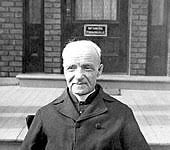As universities gear up to receive students, we should leave the travails of this world for a moment and ponder the other-worldliness of Mother Saint Teresa of Calcutta (+1997) who did not go to university, but who was nevertheless far better educated and formed than most modern graduates: Solidly grounded in what we would now know as the basic liberal arts, as everyone did in those days, young Anjeze Bojaxhiu was a polyglot, fluent in five languages, with a good deal of practical knowledge, medical and otherwise. Born and raised in the brutalist Communist nation of Albania – officially atheist – the young Catholic woman at first consecrated her life at the age of 18 to the education of girls with the Loreto Sisters in Ireland in 1928, adopting the name ‘Teresa’ after the saint of Lisieux, who is, prophetically enough, the patron of missionaries. Since the French spelling was already taken by another sister, Anjeze adopted the Spanish or Latin version, the same way the ‘other’ Carmelite Saint Teresa, of Jesus (also of Avila) spelled it.
Young Sister Teresa was posted to teach in India, where she spent twenty years as headmistress of the Loreto school in Calcutta, handing on the truth and forming the young. As time went on, the idealistic sister became increasingly disturbed by the conditions of dire, abject poverty she saw around her, with untold numbers of abandoned people quite literally dying in filth in the gutters – one of the fruits of a pagan culture with little concept of the dignity of each human person (a bereft ideology to which we are now returning). It was on September 10th, 1946, that she received a ‘call within a call’, a decisive voice from the Lord that she was to dedicate her life from here on in to the ‘poorest of the poor’, to disobey which would have been, for her, to break her faith. As she put it:
Our Lord wants me to be a free nun covered with the poverty of the cross. Today, I learned a good lesson. The poverty of the poor must be so hard for them. While looking for a home I walked and walked till my arms and legs ached. I thought how much they must ache in body and soul, looking for a home, food and health. Then, the comfort of Loreto [her former congregation] came to tempt me. “You have only to say the word and all that will be yours again”, the Tempter kept on saying … Of free choice, my God, and out of love for you, I desire to remain and do whatever be your Holy will in my regard. I did not let a single tear come.
There was nothing wrong with the relative ‘comfort of Loreto’ in itself – even if the worldly would find the strict Loreto life itself rather uncomfortable – but Sister Teresa was being called higher, to those who were lowest. She wanted at the very least to offer the dying poor a dignified death, to lift them from despair, so that they might meet their Lord with some degree of hope and love in their hearts. Sister Teresa knew that she had only what remained of her life to offer to God:
Yesterday is gone. Tomorrow has not yet come. We have only today. Let us begin.
And begin with small things, but done with great charity, as befits the very name of her new Order:
Do not think that love in order to be genuine has to be extraordinary. What we need is to love without getting tired. Be faithful in small things because it is in them that your strength lies.
The Vatican approved the diocesan congregation she founded to help the poor on October 7, 1950, the feast of the Holy Rosary, the anniversary of the battle of Lepanto, and now the founding day of the Missionaries of Charity, all of which are somehow related on God’s good providence.
The rest of now-Mother Teresa’s life is well known, and her Order – one of the strictest and most austere in the Church – has attracted thousands of young women looking for that ‘narrow path’ of heroic charity to heaven.
God doesn’t require us to succeed, he only requires that you try
After a long life of unstinting charity and uncompromising fidelity to the truth, and perhaps ironically, great fame and renown, which she always let slide off of her like water off a duck’s back, Mother Teresa died on this day, back in 1997. News of her going to eternity was overshadowed by the tragic demise of glamorous Princess Diana a week earlier in that high speed car crash in a Parisian tunnel, offering quite the historical contrast. Saint Teresa would have enjoyed being overshadowed, for she always wanted to remain humble and hidden with her poor.
As her diary later revealed, Mother Teresa suffered interiorly for most of her life in a near-unremitting dark night of the soul, yet she radiated joy wherever she went. The sometimes-physical light that shone from her led to the conversion the hard-boiled atheist Malcolm Muggeridge, when he was tasked with filming a biography of her in 1969, Something Beautiful for God (also a book, in 1971, both well worth a look).
Mother Teresa was beatified by her fellow saint (and friend) Pope John Paul II on October 19, 2003, and canonized by Pope Francis on September 4, 2016. She now rejoices with her beloved poor in heavenly glory, and leaves behind an example for us all to follow, in our own way, unto the end of time.
Mother Saint Teresa of Calcutta, ora pro nobis!










